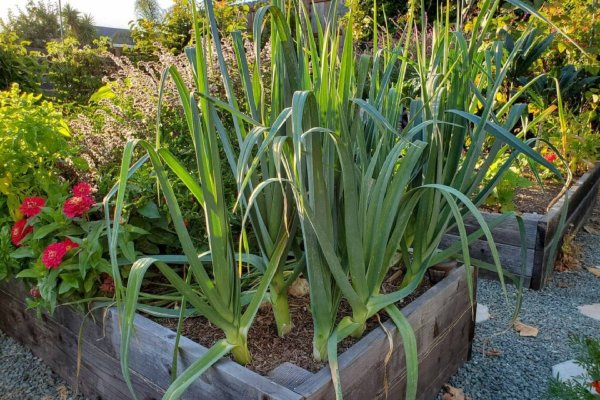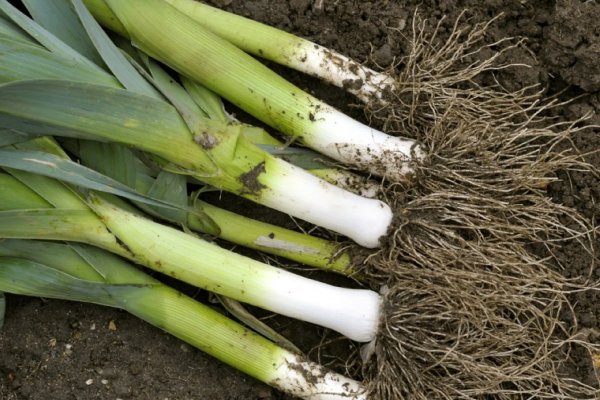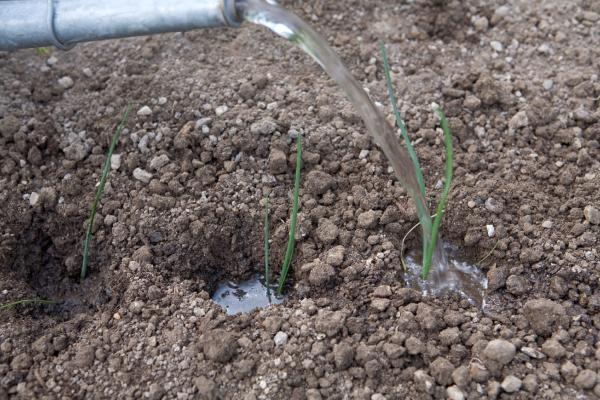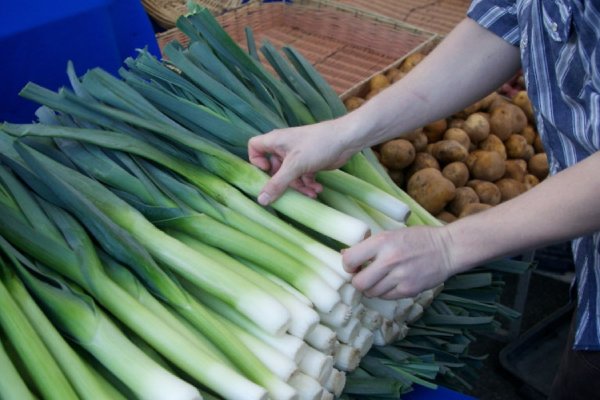Leeks are hardy vegetables that belong to the Allium family. Although it can be available throughout the year, they are a classic spring vegetable. They are most commonly found in markets from late summer to early spring. Well, leeks are often confused with green onions due to their similar characteristics. However, unlike green onions, leeks are large and do not produce bulbs, instead storing their flavor in thick, juicy stems. It has a mild, sweet flavor that is less intense than onions, becoming even sweeter when cooked. Similarly, baby leeks are tasty and tender which is best to cook for brazing, grilling, or roasting. While mature leeks are more robust, they should be thinly sliced before cooking and used in various dishes such as casseroles, soups, stir-fries, and more. Here we will further explore more about Leeks.
Plant Descriptions
Plant Type: Perennial, Annual, Vegetable
Scientific Name: Allium ampeloprasum
Family: Amaryllidaceae
Common Name: Leek
Season: Spring
Native Area: Europe, Africa
Toxicity: Toxic to pets
When and Where to Grow Leeks
Leeks grow at a slow to moderate pace and are best planted in early spring. As hardy vegetables, they can tolerate frost, so they can be planted in late summer and early fall. However, when selecting a spot to plant leeks, be careful because they have chemical compounds that can be harmful to pets. Leeks are versatile plants so they can be grown in various places including raised beds, containers, and in-ground gardens.

When planting leeks, make sure to space them a few inches apart in a sunny spot that gets bright sunlight. The soil should be nutrient-rich and well-drained. Further, it can be improved by adding aged compost or other organic matter. Although leeks are generally easy to grow, they need consistently moist soil, so it is important to check the soil moisture regularly and use a soaker hose if needed.
How to take care of a Leek?
Light
Leek thrives best in a sunny spot where they can receive at least 6 hours of sunlight each day. Without sufficient light, the plant tends to become weak and develop floppy growth.
Soil Preparations
This plant prefers well-drained loamy or sandy soil that has a slightly acidic to neutral soil pH between 6.0 and 7.0. It is important to have nutritious soil for healthy growth so, if possible, add compost or organic matter into the leek bed during the season before planting.
Water
Leeks require frequent watering to grow well. Aim to supply about an inch of water each week to keep the soil moderately moist. Typically, deep weekly watering is enough, but in hot or warm climates, you might need to increase the frequency to ensure the plants stay healthy.
Temperature and Humidity
Leeks should be planted when the temperature in the spring consistently stays above 45°F. Even though they can tolerate colder weather, these plants flourish in temperatures between 55°F and 75°F, which is when they grow most effectively. Additionally, humidity doesn’t create a problem for leeks, as long as the soil remains moist and there is sufficient airflow around the plants to keep them healthy.
Fertilizer
About a week after planting, start feeding the leeks regularly with water-soluble plant food to give them the nutrients they need. While leeks don’t need a heavy fertilizer, it is important to have nutrient-rich soil to support them as they grow. To further enrich the soil and promote healthy development, consider applying a side dressing of composted manure or an organic high-nitrogen fertilizer in midsummer. However, be sure to follow the product label instructions on the product label for the right amount to use.

Pruning
Leeks typically don’t need pruning during the growing season except for the removal of dead or diseased leaves. Throughout the growing season, you only need to harvest the mature leaves.
Pests and Diseases
Pests and diseases can be affected by common pests such as onion thrips and maggots. Fortunately, these pests can often be treated with neem oil. Similarly, it can also cause diseases such as white rot, downy mildew, and purple blotch. These fungal diseases often grow in wet conditions, so make sure to plant leeks in soil that drains well and has good airflow.
Harvesting
Leeks typically mature in about four to five months, usually ready during autumn and winter when other fresh crops are scarce. In regions with a climate of zone 7 or warmer, leeks can typically be harvested throughout the winter months. However, if you live in colder areas, you don’t need to harvest them immediately because they can tolerate some frost. You can prolong the harvesting period by applying a deep layer of mulch around the plants before a hard freeze occurs. As a result, you can leave them in the ground through the winter and pick them up whenever you need them. There are also early-growing varieties that you can harvest in summer as sweet, tender baby leeks. These are great if you have limited space or want to get results faster.
When and How to Harvest Leeks?
Ideally, you should wait until leeks are at least 1 inch in diameter for the larger white stems, but you can also pick younger leeks to use like scallions. You can harvest baby leeks in early summer to use in salads. For mature leeks, wait until late summer, when the lower stems have thickened to about 1 to 1½ inches in diameter. If the soil is moist, leeks might come out easily. If they are difficult to pull, use a spading fork to loosen the soil and then gently pull the leeks by grasping them at their base.
Storing
To store leeks, start by washing the stems thoroughly to remove any soil and grit that may have collected between the leaves. For short-term storage, which lasts up to one week, place the cleaned stems in an airtight plastic bag and store them in the refrigerator’s crisper drawer.
Whereas for longer-term storage, especially in colder zones, dig up the leeks with their roots. Place the stems in a box with the roots facing down and pack them with sawdust, clean sand, or vermiculite. Keep the packing moist and store the box in a cool place. The leeks will stay fresh for up to 8 weeks.
To freeze leeks, first, wash and slice them. Blanch the slices in boiling water for 1 minute, then drain and let them dry. Put the dried leeks in plastic freezer bags. Frozen leeks are great for soups, stews, and other dishes.

A guide to propagate Leeks
There are alternative methods to propagate leeks besides growing from seeds. Leeks can be regrown from their scraps. Instead of uprooting the entire leek plant, you can cut the leaves while leaving the root base in the soil. Then, periodically water the root base which helps to encourage new growth. After some care, you will eventually see new growth emerging from the remaining roots. Once the new growth has developed, you can easily harvest it.
Further, you can propagate leeks through division. This method can be done at any time during the growing season. Here is a step-by-step guide to help you easily regrow leeks at home:
Step 1: Remove a healthy leaf from the leek plant, ensuring it includes both the stem and roots.
Step 2: Next, trim the leaf to about an inch above the roots. Place the trimmed piece, root side down, in a small glass of water.
Step 3: Put the glass near a bright window, but ensure the cutting is not submerged in the water.
Step 4: Change the water every couple of days to keep it fresh. New growth should appear within a week.
Growing Leeks from Seeds
Leeks can be easily grown from seeds sown in spring or early summer, either indoors or outdoors. Here are detailed instructions on how to grow leeks from seeds:
- First, fill a shallow tray with a moist potting mix and start sowing seeds.
- Next, sprinkle the seeds on top and cover them lightly with the soil, as seeds need light to grow.
- For the best results, use a heat mat to keep the mix around 70°F.
- Place the tray near a bright window or under grow lights while keeping the soil consistently moist.
- Germination takes place for about two weeks. After that, you can transplant the plant into a larger space to make the most of the available area.
Conclusion
In conclusion, Leeks are a versatile and hardy vegetable that can enhance a variety of dishes with their mild, sweet flavor. They can thrive in various settings from raised beds to containers. As a result, it become a great choice for both beginner and experienced gardeners. Leeks are also frost tolerant so if they receive proper care, gardeners can achieve a successful harvest in winter as well. It is very important to provide ample sunlight, well-drained soil, and consistent moisture. Leeks can handle frost, so with the right care, you can harvest them in winter too. Make sure they get plenty of sunlight, have well-drained soil, and receive consistent moisture. Whether you choose to grow them from seeds or propagate from scraps, growing leeks provides a rewarding gardening experience and a delicious addition to your cooking.
Also read, 10 vegetables that grow well in raised beds
Frequently Asked Questions
1. What are leeks?
Leeks are hardy vegetables belonging to the Allium family. They have thick, juicy stems and a mild, sweet flavor that gets even sweeter when cooked. Unlike green onions, leeks don’t produce bulbs.
2. Which season does leek grow?
They are considered to be seasonal spring vegetables. However, they can be found in late summer into early spring.
3. How do I grow leek?
Leeks grow best when planted in early spring. They prefer a sunny spot with nutrient-rich, well-drained soil. Space them a few inches apart, and keep the soil consistently moist.
4. When and how do I harvest leeks?
Leeks are ready to harvest when their stems are about 1 to 1½ inches in diameter, usually in autumn or winter. You can also pick baby leeks in early summer for a sweeter flavor.
5. Can I propagate leeks?
Yes, leeks can be re-grown from scraps or divisions during the growing period. To regrow from scraps, leave the root base in the soil and water regularly. For division, trim a leaf with roots and place it in water until new growth appears.
